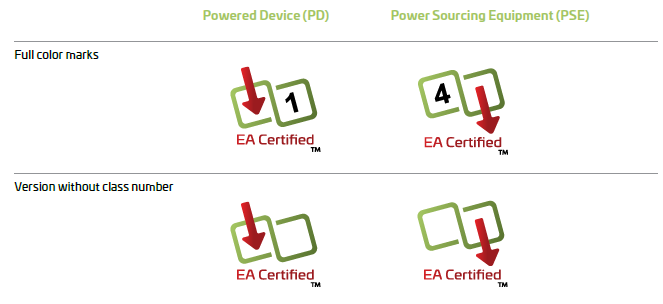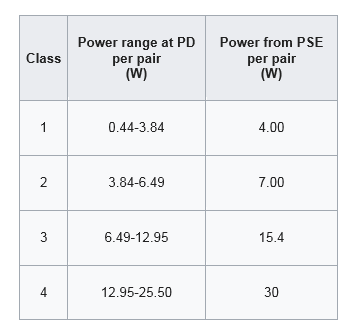SSZT767 march 2018 TPS2372 , TPS2373
In order to reach their true potential, all “standards-based” solutions such as USB and Underwriters Laboratories (UL) require an easy way to identify compliant solutions. Otherwise, a promising solution is held back over confusion and/or fear about what is really inside the box. Is it “as promoted” on the data sheet? How can you be sure? And what do you do when real-life experiences result in questioning the standard itself?
Such was the case for Power over Ethernet (PoE) – until Jan. 16, 2018.
Following a worldwide press release by the Ethernet Alliance (EA), PoE technology enters a new era in ease of adoption by providing an easy way for end users (or anyone in between) to determine if a design is compliant to the current standard – and at what power level. The new certification program also allows for faster debugging/troubleshooting when PoE systems are demonstrating interoperability issues between the PSE and PD ends of the CAT-5 cable.
As Figure 1 shows, there are essentially two categories of certification marks: one for use with powered devices (PDs), also known as “loads,” and one for power sourcing equipment (PSE), also known as “power sources.” The arrows indicate the directional flow of current in the system. In the case of PDs, the arrow points into the logo, indicating that the equipment is capable of receiving power. In the case of PSEs, the arrow points out from the logo, indicating the equipment is capable of sending power. The number inside the boxes indicate the class level certification granted (see Figure 2). For those unfamiliar with PoE, these numbers directly correspond to the maximum power a PoE-enabled design can send or receive.
 Figure 1 EA Certification Marks
(Logos)*
Figure 1 EA Certification Marks
(Logos)* Figure 2 PoE Class Levels
Figure 2 PoE Class LevelsThis initial rollout was limited in scope to the current Institute of Electrical and Electronics Engineers (IEEE) 802.3 standard (and to classes 1-4), but work is well underway to define the test suite for verifying future designs under the planned IEEE802.3bt standard (which will add classes 5-8).
TI believes that end equipment with a PoE logo provide a competitive advantage and we want to enable our customers to achieve this. TI is putting our popular EVMs and Reference Designs through EA certification so that end equipment design engineers can start from a verified solution and have higher confidence that their design will pass industry compliance testing.
Start your new PoE design with increased confidence by looking for the logo.
* EA CERTIFIED & PD Mark™ and EA CERTIFIED & PSE Mark™ and EA CERTIFIED™ are certification marks of The Ethernet Alliance in the United States and other countries. Used here under license. Unauthorized use strictly prohibited.
Additional Resources
- Check out our EA-certified PoE designs here.
- Read the EA blog post, “The Hazards of Passive PoE.”
- For more on the upcoming IEEE802.3bt standard, check out the TPS2373 and TPS2372 and read the blog post, “IEEE802.3bt: A Guide to Understanding the Current Spec.”